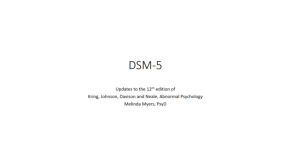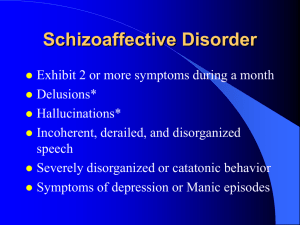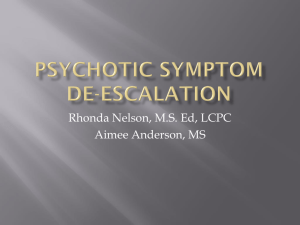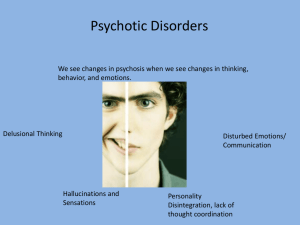Document 14081115
advertisement
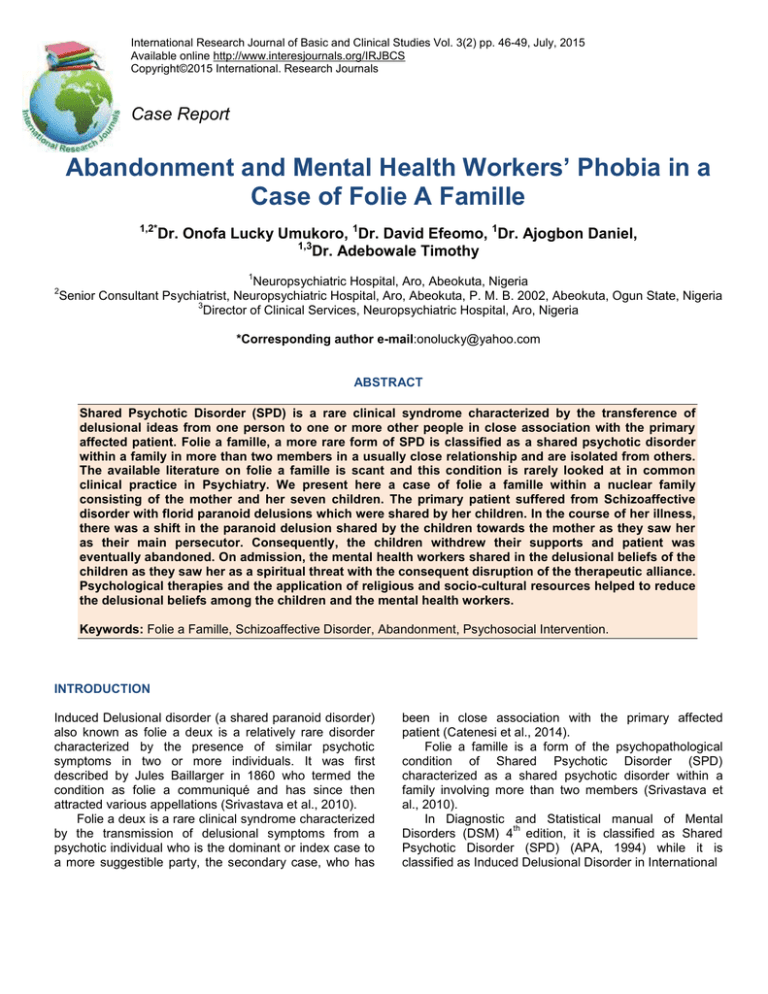
International Research Journal of Basic and Clinical Studies Vol. 3(2) pp. 46-49, July, 2015 Available online http://www.interesjournals.org/IRJBCS Copyright©2015 International. Research Journals Case Report Abandonment and Mental Health Workers’ Phobia in a Case of Folie A Famille 1,2* Dr. Onofa Lucky Umukoro, 1Dr. David Efeomo, 1Dr. Ajogbon Daniel, 1,3 Dr. Adebowale Timothy 1 Neuropsychiatric Hospital, Aro, Abeokuta, Nigeria Senior Consultant Psychiatrist, Neuropsychiatric Hospital, Aro, Abeokuta, P. M. B. 2002, Abeokuta, Ogun State, Nigeria 3 Director of Clinical Services, Neuropsychiatric Hospital, Aro, Nigeria 2 *Corresponding author e-mail:onolucky@yahoo.com ABSTRACT Shared Psychotic Disorder (SPD) is a rare clinical syndrome characterized by the transference of delusional ideas from one person to one or more other people in close association with the primary affected patient. Folie a famille, a more rare form of SPD is classified as a shared psychotic disorder within a family in more than two members in a usually close relationship and are isolated from others. The available literature on folie a famille is scant and this condition is rarely looked at in common clinical practice in Psychiatry. We present here a case of folie a famille within a nuclear family consisting of the mother and her seven children. The primary patient suffered from Schizoaffective disorder with florid paranoid delusions which were shared by her children. In the course of her illness, there was a shift in the paranoid delusion shared by the children towards the mother as they saw her as their main persecutor. Consequently, the children withdrew their supports and patient was eventually abandoned. On admission, the mental health workers shared in the delusional beliefs of the children as they saw her as a spiritual threat with the consequent disruption of the therapeutic alliance. Psychological therapies and the application of religious and socio-cultural resources helped to reduce the delusional beliefs among the children and the mental health workers. Keywords: Folie a Famille, Schizoaffective Disorder, Abandonment, Psychosocial Intervention. INTRODUCTION Induced Delusional disorder (a shared paranoid disorder) also known as folie a deux is a relatively rare disorder characterized by the presence of similar psychotic symptoms in two or more individuals. It was first described by Jules Baillarger in 1860 who termed the condition as folie a communiqué and has since then attracted various appellations (Srivastava et al., 2010). Folie a deux is a rare clinical syndrome characterized by the transmission of delusional symptoms from a psychotic individual who is the dominant or index case to a more suggestible party, the secondary case, who has been in close association with the primary affected patient (Catenesi et al., 2014). Folie a famille is a form of the psychopathological condition of Shared Psychotic Disorder (SPD) characterized as a shared psychotic disorder within a family involving more than two members (Srivastava et al., 2010). In Diagnostic and Statistical manual of Mental th Disorders (DSM) 4 edition, it is classified as Shared Psychotic Disorder (SPD) (APA, 1994) while it is classified as Induced Delusional Disorder in International Onofa et al. 47 th Classification of Diseases (ICD) 10 edition (WHO, 1992). Shared Psychotic disorder is rare, while those involving the entire family members are a much more rare condition (Howard, 1994). The rarity of this condition makes ascertainment of its prevalence difficult in the population (Peter et al., 2003). There is a dearth of literature on this condition and the few ones are majorly from the developed countries (Arnone et al., 2006). In his excellent review, Gralnick in 1942 defined Shared Psychotic Disorder as the transfer of delusional ideas and or abnormal behavior from one person to another or to several others, related or unrelated who have been in close association with the primary affected person (Srivastava et al., 2010). Social isolation has often been identified as a major risk factor for the development of folie a deux (Prochwich, 2009). The people involved often have a close emotional. relationship and mostly within a nuclear family setting and the primary partner has been noted as being older, more intelligent and better educated and the person in whom the delusions are induced is dependent on or submissive to the person with the Psychotic disorder (Foto et al., 2013). In this condition, the person who exhibits psychotic symptoms first is the primary patient that the disorder is seen among people who share the same house or are emotionally bound (Foto et al., 2013). It is also established that the person or persons who accept the delusional system are frequently more passive, less intelligent and lacking the force of character and selfesteem evinced by the inducer of the delusion (Christensen et al., 2011). In short term, physical separation of the inductor and recipient leads to better treatment results than nonseparation particularly in the case of recipient children. Long term results are seldom mentioned and documented. On the basis of theoretical considerations interventions that aim at separation in psychological terms are necessary to achieve favorable long-term treatment results (Mentjox et al., 1993). Our report also demonstrates the application of family therapy, psychosocial and cultural resources in the management of the case of folie a famille. We present here a remarkable case of folie a famille involving a mother (71years), her seven children (six males and one female) and extension of the shared delusional beliefs to mental health workers in her management team. This may be the first documented case in our area. CASE REPORT O.R, a 71 year old widow is a retired teacher who presented at our hospital with the second episode of mental illness characterized by a 3 month history of poor sleep withdrawal from her neighbors in the belief that they were plotting evil against her, and that the people in her neighborhood have conspired against her and were jealous of her achievements. She accused the people within her locality of planning to use “black juju” to kill her and her family. She heard multiple voices of unfamiliar people making derogatory comments about her and discussing her amongst themselves. The voices accused her of killing her husband, of marital infidelity, engaging in examination malpractices in school and corrupt practices before retirement. She also mentioned that the voices commanded her to run into the street against an oncoming vehicle or walk around the neighborhood naked as a form of atonement for her sin of infidelity. She became so distressed by the torment from the voices and felt life was no longer worth living. She had feelings of worthlessness and hopelessness and attempted suicide by taking a poisonous substance (Slow K liniment). During the current episode, she claimed to be a witch and claimed responsibility for the death of her husband and father who had died two years and ten years ago respectively. She also claimed she had used her supernatural power to collapse the mighty missionary church building where she worshipped in her hometown. She also claimed that she used her witchcraft to cause misfortune to some of her children who had delay in marriages and infertility. She is a known hypertensive with well controlled blood pressure on anti-hypertensive medications. Her history revealed that the first episode of mental. illness was five years ago which began less than one year after the death of her husband with whom she was married to for 48 years. She had lived in her hometown with the husband in their bungalow building and had spent most of her time after retirement to take care of the husband who was chronically ill for over five years before he died. There was a positive history of mental illness in her paternal aunt. She was diagnosed with Schizoaffective disorder, depressed subtype and was placed on Tabs Sertraline 100mg daily; Risperdal 3mg am, 3mg nocte. The children had no past psychiatric history but were found to exhibit dependent personality traits. She has seven children, of which six are mal.es and the last born a female with the oldest and youngest being 47 and 31years respectively. The children lived in the city away from their hometown but were visiting the parents from time to time. At the onset of the first episode of illness the 7 children began to share in her delusions as she imposed these beliefs in them. They believed that people in her 48 Int. Res. J. Basic Clin. Stud. locality were enemies and they withdrew socially from them. The children refrained from travelling to their hometown in an escape from the so called persecutors. However, in the current episode, there was a shift of the delusional beliefs of the children towards their mother. They consistently insisted that their mother did all things she claimed and was actually confessing her evil doings by making these utterances. Even though the children had been involved in her management at the first episode by a Psychiatrist privately, they withdrew their support from her whilst she was in the hospital and deserted her. Her first born son in particular was able to convince the rest of the children about the truth in their mother’s utterances. O.R’s delusions became systematized while on admission. She claimed responsibility for different unfortunate events while on admission in one of the female psychiatric wards in the hospital.. Two female nurses caring for her on the ward had miscarriages in the first trimester and another had a fall on the ward that resulted in a lower limbs fracture. Her primary Psychiatrist also had a car accident while she was on admission, all of which she claimed responsibility for, attributing these events to her ability to cause negative events by witchcraft of first class hierarchy. Subsequently, the nurses and other mental health workers began to share in this believe as she was perceived as a spiritual and material threat. They began to hold regular prayer sessions on the ward because they were afraid of her and were reluctant to care for her. INTERVENTIONS Psychological interventions for O. R included cognitive behavioural therapy and insight oriented therapy. There were extensive family therapy sessions including psychoeducation on the nature of her illness. The family requested to explore religious-spiritual alternative of taking her to a renowned church where deliverance was administered by the men of God to her and children. Two of the sons became church pastors and the rest became dedicated church workers. For the mental health workers, there were psychoeducational programmes with the team members. An extensive clinical case conference which gives opportunity to the clinical management team and staff members to ventilate their fears was done. The Director of Clinical Services of the hospital who led this case conference provided a wide range of counseling and psychoeducation which resulted in a positive attitude of the health workers towards the patient. She made appreciable improvement in her mental state and the intensity of the delusional beliefs became drastically reduced. She was discharged home after 10 weeks on admission. She suffered a relapse due to poor compliance with medications and was re-admitted. The mental health workers had a good therapeutic relationship afterwards with patient. She spent a further 22 weeks on admission before being discharged home. There was a concrete rotational arrangement for patient to stay with the children in the city. In the following two years, 2 of her sons got married and 2 of them with infertility were blessed with children. She became a proud grandmother taking care of the children. She had good social recovery with some symptoms. The children all came together and celebrated nd her 72 birthday as an evidence of social re-union. DISCUSSION Our case illustrates a case of folie a famille involving a mother and her seven grown up children with extension to mental health workers. O.R. was the dominant person who suffered from Schizoaffective disorder with florid persecutory delusions while other family members shared in her delusional beliefs. She had an abnormal grief reaction to the death of her husband whom she had to spend her retirement period to take care of as he was chronically ill unto death. The stress of taking care of the late husband could serve as a precipitant to her illness. She also invariably suffered some social isolation spending most of her time all alone with the sick husband. Social isolation has often been described as a major risk factor for the development of folie a deux (Arnone et al., 2006). Taking into account the development of delusions from the primary inducer to secondary, published literature has described a high level of psychiatric morbidity in the secondary accompanied by an extensive family history of Psychiatric illness. Thus in this context, exposure to the primary inducer could act as a psychological trigger for a transient psychotic phenomenon in a subject who would have developed a psychotic episode in any case (Arnone et al., 2006). However, the children of the primary inducer did not have any primary psychiatric diagnosis. Sharing of these delusions in the family contributes to the development of a paranoid pseudo-community. The children eventually gained insight and took part in the psychological and family therapy. A number of factors reported in the secondaries in more recent years include; passive personality, cognitive impairment, language difficulties and life events, some of which may Onofa et al. 49 be explanation for the development of delusion in the secondaries, in this case, O.R’s children. This case further demonstrates the complexity of presentation of folie a famillie extending to mental health workers. To the best of our knowledge, published literature on health workers sharing in patients’ delusion is very scant. However, there has been report of folie a deux occurring in unrelated individuals and unlike the usual clinical picture they did not live in social isolation, rather they lived in an apartment in a well-known residential area of the city (Jana et al., 2009). The belief in witchcrafts and the religious-spiritual therapy subscribed to in our case report gave credence to the earlier assertion by Erinoso in his 1976 article “Evolution of modern Psychiatric care in Nigeria” where he mentioned that in Nigeria, mental illness is seen as being rooted in evil machinations of the enemies, cosmic forces or excessive strain in interpersonal relationship (Erinoso, 1979). In our case report, this belief system does not appear to have changed over the years. Erinoso further pointed out that it may be futile for health professional. in Nigeria to adopt a solely Western Oriented approach to mental health care when the ideas of the patients who they treat are deeply rooted in magico-religious belief systems and in the utilization of traditional healers. It is evident that patients would not derive maximum treatment benefits if their ideas or concerns about mental illness were merely dismissed by Western-Oriented professionals on the grounds that such notions of illness have no foundation in scientific psychiatry. In our case repot, the use of psychotropic medications, psychological therapy and the utilization of socio-cultural and religious resources were germane to achieving improvements and restoring cordiality in social relationship. CONCLUSION delusions. The disorder is rare but its proper recognition and appropriate application of psycho-pharmacological psychosocial interventions can result in good treatment outcomes. The need to understand the peculiarities of the disorder in Nigeria and other developing countries and the utilization of socio-cultural resources cannot be overemphasized REFERENCES Srivastava A, Barkar HA. Folie a famille (2010). Ind. J. Psych. 52(1): 69-70 Catenesi R, Punzi G, Rodriguez WC, Solarino B, Dievella G (2014). Faith, folie a famille and mummification: a brief review of literature and a rare case report. J. forensic Sci. 59(1): 274-280 American psychiatric Association (1994). Diagnostic and Statistical manual of mental disorders 4th edition Washington DC; American Psychiatric Association. The ICD-10 classification of mental and behavioural disorders, Geneva (1992). World Health Organization Howard R (1994): Induced Psychosis. BJ Hosp. Med. 51: 304-307 Peter M, Wehmeire NB, Remschmidt H (2003). Induced delusional disorder; A review of the concept and unusual case of folie a famille Psychopathology. 36: 37-45 Arnone D, Patel A, Tan GM (2006). The nosological significance of folie a deux: a review of the literature; Annals of general psychiatry. 5:11 Prochwicz K (2009). Insanity of two Clinical symptomatology and psychosocial factors of induced paranoid disorder. Psychiatria Polska. 43(1):19-30 Foto D, Golkler B, Evin SG, Bal.seven A (2013). A case of munchausen syndrome by proxy in the context of folie a famille. Turkish Journal of Psychiatry 24(4):275-279 Christensen RC, Ramos E (2011). The social treatment consequences of a shared delusional disorder in a family. Innovations in clinical neurosciences 8(4):42-48 Mentjox R, Van CA, Kooiman CG (1993). Induced psychotic disorder: clinical aspect, theoretical considerations and some guidelines for treatment. Comprehensive Psychiatry 34(2); 120-126 Jana AK, Praharaj SJ, Sarkar S, Dotivala KN, Chabungbam G (2009). Folie a deux between two unrelated individuals. Turkish Journal of Psychiatry of Psychiatry. 20(3):299-304 Erinoso OA (1979). The evolution of modern psychiatric care in Nigeria. The American Journal of Psychiatric. 136(12):1572-1575 Our remarkable case of folie a famille demonstrates the complexity of the disorder with the consequent behavioral and psychosocial impairments caused by shared How to cite this article: Onofa et al. (2015). Abandonment and Mental Health Workers’ Phobia in a Case of Folie A Famille. Int. Res. J. Basic Clin. Stud. 3(2):46-49
